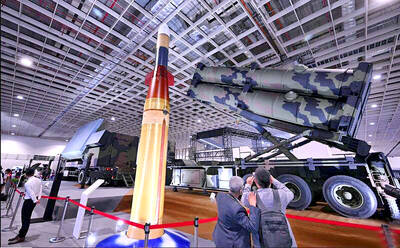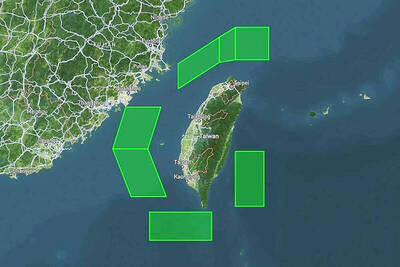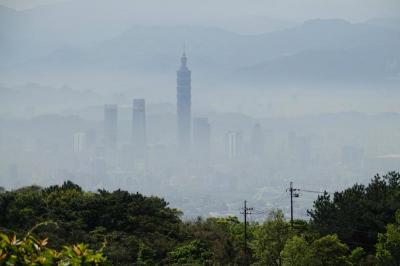Most countries do not ban or limit the use of crystalline silica in cosmetics, the Food and Drug Administration (FDA) said, adding that it would continue to reference international regulations and revise regulations accordingly.
The agency issued the remarks after an academic suggested banning or limiting the mineral’s use to reduce risk of lung cancer in women.
A Taiwanese biotech company in 2019 was producing cosmetics products in China, and Kuo Ching-tang (郭錦堂), then a China Medical University professor, was commissioned by the FDA to test 13 of the company’s products.

Photo: Taipei Times file
Some products were found to contain asbestos and were ordered to be removed from shelves, while 11 products had crystalline silica, also known as “free” silica, Kuo said.
Kuo said he randomly tested three cosmetic products this year — an eyeshadow, a powder foundation and a setting powder — from three different brands, and found that they were free of asbestos, but the eyeshadow and setting powder contained crystalline silica.
He suggested that the government ban or limit the chemical’s use in cosmetics to reduce the risk of lung cancer in women.
Quartz is the most common form of crystalline silica, and has stable chemical property and low solubility, said Kuo, a professor at National Changhua University and an on-site evaluation expert for the National Environmental Research Academy.
However, if people inhale tiny particles of crystalline silica, it can penetrate deep into the lungs and are hard to remove, he said, adding that prolonged exposure can lead to lung disease, lung inflammation and lung cancer.
Kou said most people have very low exposure to crystalline silica in the environment, but miners or people who work in stone cutting or processing, casting and refractory brick production might often be exposed to it, and the government has set exposure limits.
However, crystalline silica is used in cosmetic products to absorb oil and reflect light, which makes the skin look brighter and more delicate, he said.
It is easy to inhale as it is frequently used near the mouth and nose, which makes it more harmful, but there are no limitations to its use in cosmetic products, Kuo said.
Prolonged inhalation of high levels of crystalline silica increases the risk of lung cancer, so although it is unlikely to inhale high levels from cosmetics, the government could consider evaluating the risks to protect people’s health, Chang Gung Memorial Hospital Clinical Poison Center director Yen Tzung-hai (顏宗海) said.
Silicon dioxide, also known as silica, is found naturally in stone, sand, mud, dirt, air and water, and its common products include brick, glass, ceramic, plaster, granite, concrete, detergent, skin care and cosmetic products, the FDA said in response.
The International Agency for Research on Cancer (IARC) listed respirable crystalline silica in the form of quartz or cristobalite dust as a human carcinogen, because inhaling it might increase the risk of developing lung cancer, the FDA said.
However, most cosmetic products are in the form of liquid or cream, so the risk of inhaling it is low, it said, adding that if people who use powder cosmetics should dab an appropriate amount of product and avoid patting it too hard on the face to reduce the risk of inhaling the powder.
Countries, including the US, EU members, ASEAN members, Japan, China, Canada and South Korea do not ban nor limit the use of silica in cosmetic products, so the regulations in Taiwan are similar to those countries, the FDA said, adding that it would continue abiding by international regulations and revise regulations accordingly.
Asked whether silica is listed as a toxic chemical, the Ministry of Environment said the chemical widely exists in the natural environment and does not meet the definition for controlled toxic chemical substances, and that other countries have not listed it as a toxic chemical either.
Silicon dioxide exists in the natural environment in many forms, including crystalline and non-crystalline, and the most common form of crystalline silica is quartz, the National Environmental Health Research Center said.
Long-term inhalation of tiny-particle crystalline silica dust could increase the risk of silicosis, which is a lung disease, so it is listed as a Group 1 carcinogen by the IARC, but studies have not found non-crystalline silica to be carcinogenic to people or animals, the research center said.
Healthy people without lung disease would not experience negative health effects from exposure to larger-particle crystalline silica or non-crystalline silica, so they do not need to take particular measures in daily life to avoid silica products, it said.
Additional report by Chen Chia-yi

Taiwan is to commence mass production of the Tien Kung (天弓, “Sky Bow”) III, IV and V missiles by the second quarter of this year if the legislature approves the government’s NT$1.25 trillion (US$39.78 billion) special defense budget, an official said yesterday. Commenting on condition of anonymity, a defense official with knowledge of the matter said that the advanced systems are expected to provide crucial capabilities against ballistic and cruise missiles for the proposed “T-Dome,” an advanced, multi-layered air defense network. The Tien Kung III is an air defense missile with a maximum interception altitude of 35km. The Tien Kung IV and V

The disruption of 941 flights in and out of Taiwan due to China’s large-scale military exercises was no accident, but rather the result of a “quasi-blockade” used to simulate creating the air and sea routes needed for an amphibious landing, a military expert said. The disruptions occurred on Tuesday and lasted about 10 hours as China conducted live-fire drills in the Taiwan Strait. The Civil Aviation Administration (CAA) said the exercises affected 857 international flights and 84 domestic flights, affecting more than 100,000 travelers. Su Tzu-yun (蘇紫雲), a research fellow at the government-sponsored Institute for National Defense and Security Research, said the air

A strong continental cold air mass is to bring pollutants to Taiwan from tomorrow, the Ministry of Environment said today, as it issued an “orange” air quality alert for most of the country. All of Taiwan except for Hualien and Taitung counties is to be under an “orange” air quality alert tomorrow, indicating air quality that is unhealthy for sensitive groups. In China, areas from Shandong to Shanghai have been enveloped in haze since Saturday, the ministry said in a news release. Yesterday, hourly concentrations of PM2.5 in these areas ranged from 65 to 160 micrograms per cubic meter (mg/m³), and pollutants were

Taiwan’s armed forces have established response protocols for a wide range of sudden contingencies, including the “Wan Chun Plan” to protect the head of state, the Ministry of Defense (MND) said today. After US President Donald Trump on Saturday launched a series of airstrikes in Venezuela and kidnapped Venezuelan President Nicolas Maduro, concerns have been raised as to whether China would launch a similar “decapitation strike” on Taiwan. The armed forces regularly coordinate with relevant agencies and practice drills to ensure preparedness for a wide range of scenarios, Vice Minister of National Defense Hsu Szu-chien (徐斯儉) told reporters before a